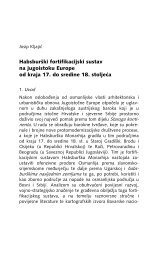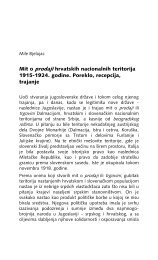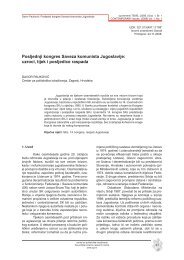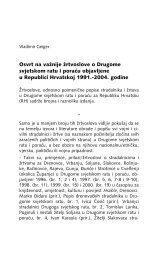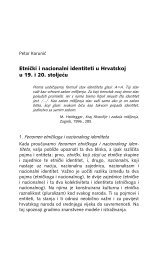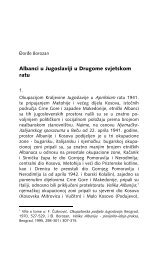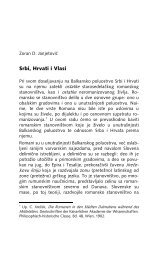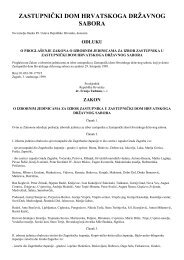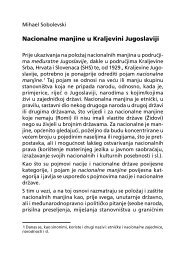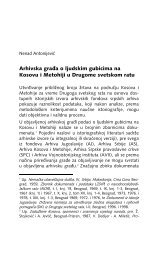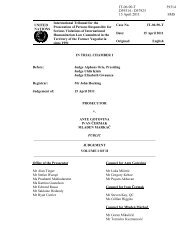ISSN 1847-2397 godište II broj 1 2009. | volume II number 1 2009
ISSN 1847-2397 godište II broj 1 2009. | volume II number 1 2009
ISSN 1847-2397 godište II broj 1 2009. | volume II number 1 2009
- No tags were found...
You also want an ePaper? Increase the reach of your titles
YUMPU automatically turns print PDFs into web optimized ePapers that Google loves.
Plamena Pehlivanova: The Decline of Trust in Post-Communist Societiessuvremene TEME, (<strong><strong>2009</strong>.</strong>) God. 2, Br. 1CONTEMPORARY issues, (<strong>2009</strong>) Vol. 2, No. 14. AgeIn order to dig deeper into the causalityof the decline in trust and participation of theBulgarian, Russian and Chinese society, wemust look at the age distribution in these countries(Table 2). It is striking to see that 23.3% ofthe Bulgarian society consists of people over 65years old, while in the Chinese they compriseonly 6% of the population. There is a big differencein Bulgarian and Chinese demographics,where the Bulgarian population growth rateis -0.813% (2008 est.), the Chinese is 0.629%(2008 Est.). How does this affect the reports ontrust and participation of the two populations?The older generation in Bulgaria reportsto participate least in voluntary organisations andexpresses the highest dissatisfaction with life.For example, to the question in the World ValueSurvey: “Please look carefully at the followinglist of voluntary organisations and activities andsay...which, if any, you belong to?” 79% of theBulgarians answered “Belong to none”. Herewe see that only 20% of Bulgarians and 32% ofRussians belong to any voluntary organisations,in contrast to 92% of Dutch. In order to explainthis phenomenon of decline in associational lifewe must look at two factors: age and income ofthe population. As previously noted, 43% of theinterviewed Bulgarians is above 50 years of age;while in China it is only 25%. In other words, thedominant population of Bulgaria consists of elderly(born after 1951) while China consists ofpredominantly 33-49 year olds. Therefore, theanalysis has to control for the variable of age andincome to see whether their effect on participation.When controlling for age, the World ValueSurvey presents that 46% (BG) of the “Belongto None” section is made up of people above 50years old (Table 3). Interestingly enough, theChinese model shows that 43% of the “Belong toNone” section is composed of 15-29 year olds.Therefore, the Bulgarian and Chinese modelseems to differ in the level of participation betweentheir age groups. What does this tell usabout the younger generation in China and theolder generation in Bulgaria? Since the Bulgarianpopulation is dominated by the older generation,we see that this survey on participation isalso influenced by the opinions of the elderly.The outcomes also support observationsmade by Terry Clark in his The New PoliticalCulture that younger people participatemore than the elderly (Clark, Hoffmann-Martinot,1998:126). In support of the New Political Model,we see that in Bulgaria there is a decline in associationallife with the increase of the age factor.Similarly, the table below shows a decrease incultural activism with the increase of age.5. Social and Cultural ParticipationJames Coleman and Robert Putnamboth emphasize trust as an important factor forthe establishment of civil society, the sense ofcommunity and connection between citizens ininstitutions that connect them with government.Political activism is an example where the socialtrust is measured in participation. In BowlingAlone, Robert Putnam chooses bowling asTable 2:Participation declines with AgeAge vs. Mean of Belonging to Cultural Organisations15-24 0,17525-34 0,12335-44 0,1145-64 0,165 0,085Survey conducted by Terry Clark, University of Chicago* This table controls for the Age vs. Mean of people belonging to CulturalActivitiescentar za politološka istraživanjathe political science research centrewww.cpi.hr36



